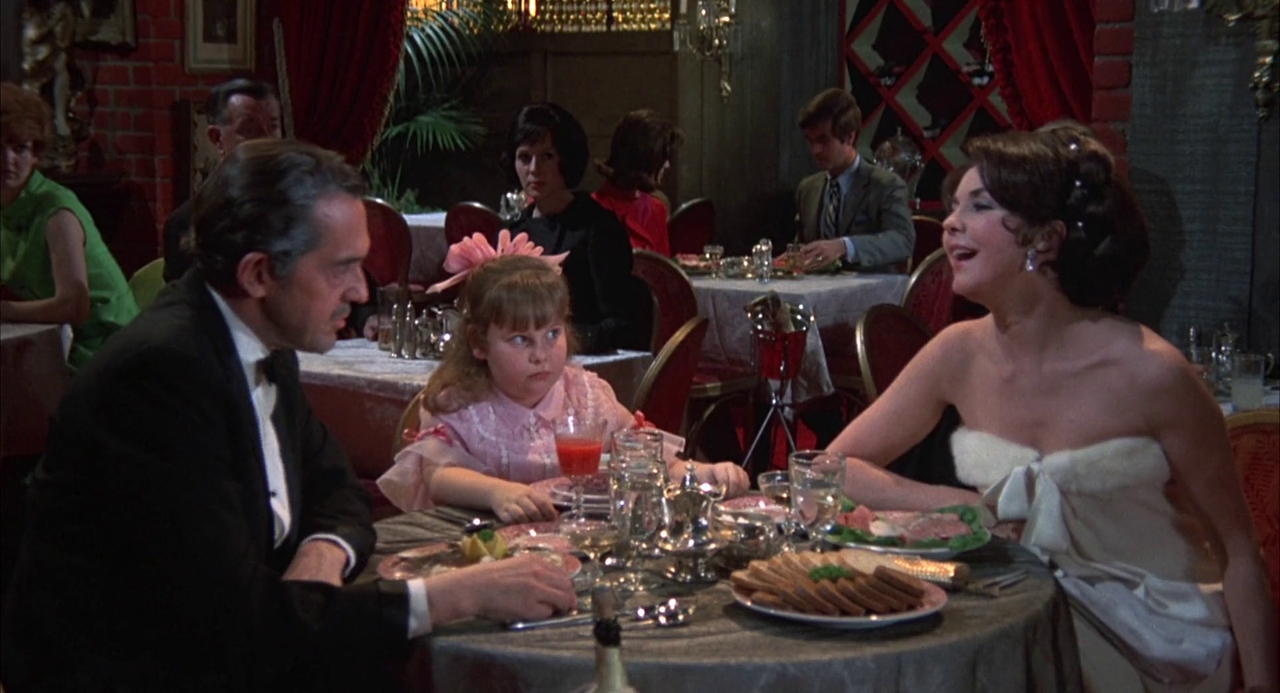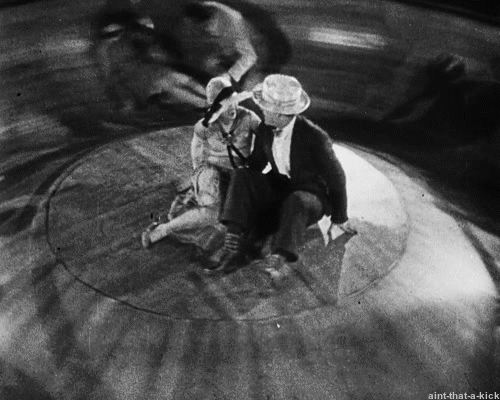“We say hip, hooray,
Hip, hip hooray,
For fat!”Angel, Angel, Down We Go [Cult of the Damned (Robert Thom, 1969)
Dec
22

A chubby, piggy pink-dressed debutante (Joan Calhoun) flanked by her uppity-class parents (Charles Aidman and Jennifer Jones) in a fancy restaurant. The kid gives her mother the side eye. Other eaters look on in shock. DP: John F. Warren.
– Barry Mann & Cynthia Weil, The Fat Song
comedy
“Selling the Brooklyn Bridge again, huh?”Every Day's a Holiday (A. Edward Sutherland, 1937)
Nov
21
National Entrepreneurs Day

Lobbycard. Peaches O'Day (Mae West, dressed by Schiaparelli) hands her business card to yet another sucker. They're on the Brooklyn Bridge, which can be seen in the background. DP: Karl Struss.
The main character is an entrepreneur: National Entrepreneur's Day (USA)
In my book, entrepreneur is just a fancy talk for conman. A famous one, the one who may've tried to sell you the Brooklyn Bridge, was George C. Parker. He'd peddle the famous landmark to any hapless rube, immigrant, or sucker who then would promptly erect a little tollbooth to make a fast buck from any hapless rube, immigrant, or sucker.
– Police captain Jim McCarey
Like Parker, Mae West's Peaches O'Day bamboozles it her way. And boy, does she have a bridge to sell you!
– Nice day, isn't it?
– Yes, isn't it!
– It's swell. It's perfect.Lonesome (Pál Fejős, 1928)
Nov
20
A Beautiful Day

Our lovebirds holding out on the Human Roulette, one of the many dizzying Steeplechase attractions of Coney Island. DP: Gilbert Warrenton.
A beautiful day for Beautiful Day (USA??).
Two hopelessly lonely hearts meet each other at Coney Island, spending the most wonderful day in each other's company. Pál Fejős' joyful Lonesome was made just when motion pictures became talkies, and new and more modern novelties were expected by the audience. Fejős delivers, with sound and musical inserts, and the occasional – almost shocking – burst of colour.
With light touches of Murnau's groundbreaking Sunrise: A Song of Two Humans (1927) and Jean Vigo's more experimental À propos de Nice (1930), Lonesome depicts the exuberance of youth with an optimism soon to be lost to the vices of history.
“Fame will go by, and so long, I've had you, fame.”Something's Got to Give (George Cukor, 1962)
Nov
10
Forget-Me-Not Day

Marilyn on set during the infamous pool scene, four days days after singing Happy Birthday at JFK's birthday gala. DPs: Franz Planer & Leo Tover.
Everyone assumed that Ellen Arden, swept away during a yacht race, was gone. But there she is, years later, and very much alive.
– Marilyn Monroe, 1962
The story ends on August 4, 1962, almost two months after she was fired from the shoot. Marilyn Monroe was found dead in her home. She was 36 years old.
瘋癲老人日記 [Fūten rōjin nikki / Diary of a Mad Old Man] (Keigo Kimura, 1962)
Oct
29
World Stroke Day

Utsugi (Sō Yamamura) lusting after his daughter-in-law Sachiko's (Ayako Wakao) feet while she takes a shower. DP: Nobuo Munekawa.
“Any resemblance between HELLZAPOPPIN’ and a motion picture is purely coincidental”Hellzapoppin' (H.C. Potter, 1941)
Oct
24
National Crazy Day

Olsen and Johnson break all the walls. DP: Elwood Bredell.
– tagline
“It was fear that created the first gods.”Привързаният балон [Privarzaniyat balon / The Tied-Up Balloon] (Binka Zhelyazkova, 1967)
Oct
1
Balloons Around The World Day

The balloon sails along as a young woman in white (Janet Miteva) walks with it. DP: Emil Vagenshtain.
One day, a large blimp shows up over a small Bulgarian village. The townspeople, seeing the prosperity in all that beautiful silk and then some, go after it.
– Stratius
“It doesn't hurt to fall off the moon.”Céline et Julie vont en bateau: Phantom Ladies Over Paris [Celine and Julie Go Boating] (Jacques Rivette, 1974)
Sep
17
National Women's Friendship Day

Celine (Juliet Berto) leans into Julie (Dominique Labourier) in the back of a car. DP: Jacques Renard.
– Julie
“No, no, geh' nicht vorbei, als wär' nichts gescheh'n,
Es ist zu spät, um zu lügen,
Komm und verzeih, ich werd' mit dir geh'n,
Wohin dein Weg auch führt,
Und die Welt, sie wird schön.”Warum läuft Herr R. Amok [Why Does Herr R. Run Amok] (Michael Fengler, 1970)
Sep
11
National Boss Employee Exchange Day

Der Chef (Franz Maron) berates Herr R. (Kurt Raab). DP: Dietrich Lohmann.
Mr R. (Kurt Raab), his full name is irrelevant, is a hardworking, almost invisible man. He laughs along when his coworkers make stale jokes to shorten the long days. He neatly completes his draftman's assignments and politely nods when the boss berates him. He smokes too much, 80 a day, and at the yearly checkup is told to cut the habit down. His son fails at school and Mrs R. wishes for nicer furniture and a skiing holiday, when Mr R. is promoted.
– Christian Anders, Geh nicht vorbei (1969)
So why does Herr R run amok?
“Was ist loos? Der Hund is loose.” Stroszek (Werner Herzog, 1977)
Sep
9
German Language Day

A warm Railroad Flats, Wis. “Willcomen” [sic] for (LtR) Scheitz, Eva, and Bruno, with Mr Scheitz's nephew (Clayton Szalpinski) squeezed between his “Onkellein” and Eva. DP: Thomas Mauch.
Bruno Stroszek (Bruno S.), his friends Eva (Eva Mattes) and Scheitz (Clemens Scheitz, responsible for the fairy-tale music you hear in this film) decide to leave dreary #Berlin behind and move to #Wisconsin where the latter's nephew lives. A new life, with dreams of music and animal magnetism, awaits them there.
– Clayton
As so oft with #Herzog, the story behind Stroszek is as engrossing as the resulting film. Documentary maker Errol Morris and Herzog were fascinated by Wisconsin's own Ed Gein and wondered if Gein had dug up his own mother, as was rumoured at the time. As they would, they decided to open the poor woman's grave. Morris never showed up, and neither did Herzog but only because his car broke down en route to Plainfield, Wisconsin. Trying to get the vehicle fixed, Herzog entered the workshop of a Clayton Szalpinski.
A character in his own right, and a non-actor to boot, Clayton ended up in Stroszek as Scheitz's nephew; a MacGuffin odder than a dancing chicken.